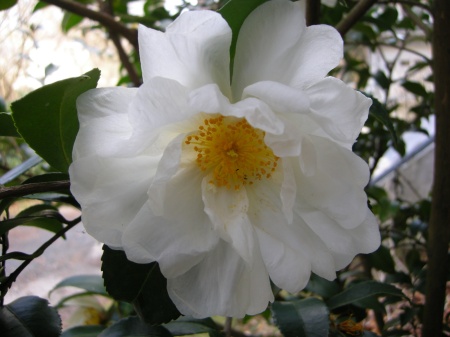Carolyn’s Shade Gardens is a retail nursery located in Bryn Mawr, PA, specializing in showy, colorful, and unusual plants for shade. The only plants that we ship are snowdrops and miniature hostas. For catalogues and announcements of events, please send your full name, location, and phone number (for back up use only) to carolyn@carolynsshadegardens.com. Click here to get to the home page of our website for catalogues and information about our nursery and to subscribe to our blog.
 My garden reaches one of its peaks when the doublefile viburnum, V. plicatum var. tomentosum, is blooming. It has such a beautiful habit and way of holding its flowers. I am offering the award-winning cultivar ‘Shasta’.
My garden reaches one of its peaks when the doublefile viburnum, V. plicatum var. tomentosum, is blooming. It has such a beautiful habit and way of holding its flowers. I am offering the award-winning cultivar ‘Shasta’.
.
My nursery, Carolyn’s Shade Gardens, specializes in perennials for shade with an emphasis on hellebores, unusual bulbs especially snowdrops, hostas particularly miniature hostas, native plants, and ferns. However, a satisfying shade garden does not consist of just perennials but includes trees, shrubs, and vines. I provide a quality source for these plants by doing a special offer three times a year.
I have just sent my second 2013 list to my customers. To view the catalogue, click here. However, I always do a post on the plants offered so that my blog readers who are not customers can learn about the woody plants that I would recommend they add to their shade gardens. And doing an article allows me to add more information and explain why I chose the plants I included so customers might be interested also.
.
 ‘Winter’s Darling’ fall-blooming camellia with ‘Moudry’ black fountain grass.
‘Winter’s Darling’ fall-blooming camellia with ‘Moudry’ black fountain grass.
This offer focuses on plants that are late spring-, summer-, or fall- blooming, evergreen, and/or native.. Included are two camellias, two additional evergreen shrubs, four deciduous shrubs, and three vines. Four of the plants I have chosen are evergreen, and five bloom off season, in summer or fall. This reflects my desire to see gardeners expand their gardens’ season beyond spring to become a year round paradise for them to enjoy. With that introduction, here are the plants I am highlighting:
 ‘Winter’s Darling’
‘Winter’s Darling’
I have included two fall-blooming hardy camellias for their spectacular late season flowers and elegant evergreen leaves. These camellias, along with many other cultivars, have been selected to be fully cold hardy in the mid-Atlantic U.S., zones 6B and 7A. Nevertheless all camellias benefit from being sited to shelter them from winter wind, which comes from the northwest. They also maintain their lustrous dark green leaves in better shape if they are sheltered from winter sun.
‘Winter’s Darling’ is a camellia cultivar suitable for our area because it was selected for its cold hardiness by Dr. William Ackerman at the U.S. National Arboretum. It has very showy deep cerise pink anemone form flowers in November and December and glossy dark evergreen leaves. It grows slowly to 6′ tall and 5′ wide in part to full shade. In my garden, it has a shorter and more relaxed habit than my other camellias.
.
 ‘Northern Exposure’ fall-blooming camellia. Thanks to Monrovia for allowing me to use their photo.
‘Northern Exposure’ fall-blooming camellia. Thanks to Monrovia for allowing me to use their photo.
I don’t currently grow the fall-blooming camellia ‘Northern Exposure’, but I am ordering one now to add to my garden. It has gorgeous pale pink plump buds that open to very large, single white flowers with bright yellow stamens over a long period of time in fall and winter and glossy dark evergreen leaves. It is 6’ tall and 5′ wide, growing in part to full shade.
.
 ‘Gulftide’ holly osmanthus (also known as holly tea olive or false holly), O. heterophyllus, blooms in the fall and is fragrant.
‘Gulftide’ holly osmanthus (also known as holly tea olive or false holly), O. heterophyllus, blooms in the fall and is fragrant.
Fall-blooming holly osmanthus ‘Gulftide’ is one of two additional evergreens in the offer, and I would grow it just for its dramatic, stiff and pointy, lustrous dark leaves. Its small fragrant flowers perfume the garden in fall and the prickly foliage repels deer. It grows slowly up to 8 to 10’ tall and 4’ wide in part to full shade. It has a dense and compact habit and is very adaptable as to soil type It is the most cold hardy of the osmanthus, suitable for zones 6 and higher. For some reason it is hard to find and sells out immediately so if you want one, send me an email right away. The nursery just notified me that they also have available a very limited number of the cultivar ‘Sasaba’ which sold out in my last offer.
.
 I have offered the hybrid leatherleaf viburnum ‘Dart’s Duke’, V. x rhytidophylloides, before, and it is profiled in Woody Plants for Shade Part 3. I am including it again because it is such a versatile evergreen, deer resistant plant, growing in sun or shade and making an excellent screen or hedge with gorgeous flowers. A Pennsylvania Horticultural Society Gold Medal Plant in 2012.
I have offered the hybrid leatherleaf viburnum ‘Dart’s Duke’, V. x rhytidophylloides, before, and it is profiled in Woody Plants for Shade Part 3. I am including it again because it is such a versatile evergreen, deer resistant plant, growing in sun or shade and making an excellent screen or hedge with gorgeous flowers. A Pennsylvania Horticultural Society Gold Medal Plant in 2012.
.
There are four deciduous shrubs in the offer:
 Native hybrid ‘Hartlage Wine’ sweetshrub, Calycanthus raulstonii, is another repeat and was profiled in Woody Plants for Shade Part 1. This shrub is in its glory right now with its gorgeous wine-red flowers set off beautifully by the smooth bright green leaves, one of my favorites.
Native hybrid ‘Hartlage Wine’ sweetshrub, Calycanthus raulstonii, is another repeat and was profiled in Woody Plants for Shade Part 1. This shrub is in its glory right now with its gorgeous wine-red flowers set off beautifully by the smooth bright green leaves, one of my favorites.
.
 The lovely flowers of ‘Tokyo Delight’ bigleaf hydrangea have an outer rim of white with a deep sky blue center.
The lovely flowers of ‘Tokyo Delight’ bigleaf hydrangea have an outer rim of white with a deep sky blue center.
.
 ‘Tokyo Delight’ has an excellent habit and produces copious amounts of blooms.
‘Tokyo Delight’ has an excellent habit and produces copious amounts of blooms.
.
‘Tokyo Delight’ bigleaf hydrangea, H. macrophylla, is a wonderful compact hydrangea that produces beautiful lacecap flowers with large white outer blooms and sky blue inner blooms for an extended period in summer. The flowers age to a lovely, long-lasting rose color. It is very cold hardy and blooms reliably every year. It grows to 4’ tall and 3’ wide in part to full shade in zones 5 to 9.
.
 Plum leaf azalea is one of our wonderful deciduous U.S. native rhododendrons.
Plum leaf azalea is one of our wonderful deciduous U.S. native rhododendrons.
.
Native plum leaf azalea’s, Rhododenron prunifolium, striking 2″ orange to red flowers from June into August make this deciduous rhododendron a wonderful addition to the summer shade garden. The flowers attract hummingbirds. Plum leaf azalea has delicate, bright green leaves and a lovely upright habit with tiered branching. It grows up to 8’ tall and 4’ wide in full sun to almost full shade in zones 5 to 9.
.
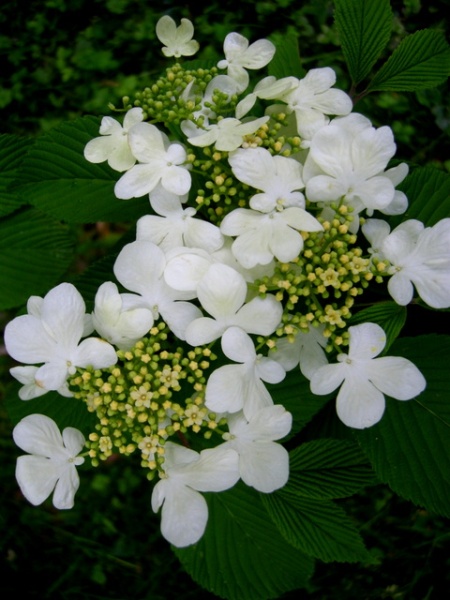 The elegant flowers and pleated leaves of doublefile viburnum.
The elegant flowers and pleated leaves of doublefile viburnum.
.
‘Shasta’ doublefile viburnum, V. plicatum var. tomentosum, was introduced by the U.S. National Arboretum as a cultivar with extra large flowers and a shorter more horizontal habit. It produces its showy lacecap flowers in May and June, and they are displayed in a unique “doublefile” along the stems. Its has pretty pleated medium green leaves and produces bright red berries in late July, which the birds love. It grows quickly to 7’ tall and 10’ wide in part to full shade in zones 5 to 8. ‘Shasta’ is deer resistant and is a PHS Gold Medal Plant. I treasure my doublefile for its elegant “wedding cake” habit (see the first photo in the post)—one of the most noticed plants in my garden.
.
 ‘John Clayton’ is the most vigorous and produces the most flowers of any of the native honeysuckle vines.
‘John Clayton’ is the most vigorous and produces the most flowers of any of the native honeysuckle vines.
.
 ‘John Clayton’ native trumpet honeysuckle, Lonicera sempervirens, was featured previously in Woody Plants for Shade Part 3, but I am offering it again because it is such a carefree vine for part shade.
‘John Clayton’ native trumpet honeysuckle, Lonicera sempervirens, was featured previously in Woody Plants for Shade Part 3, but I am offering it again because it is such a carefree vine for part shade.
.
 Native ‘Amethyst Falls’ American wisteria, W. frutescens, was profiled previously in Woody Plants for Shade Part 2, but again it is such a wonderful vine as shown by its PHS Gold Medal Plant status that I am including it in this offer.
Native ‘Amethyst Falls’ American wisteria, W. frutescens, was profiled previously in Woody Plants for Shade Part 2, but again it is such a wonderful vine as shown by its PHS Gold Medal Plant status that I am including it in this offer.
.
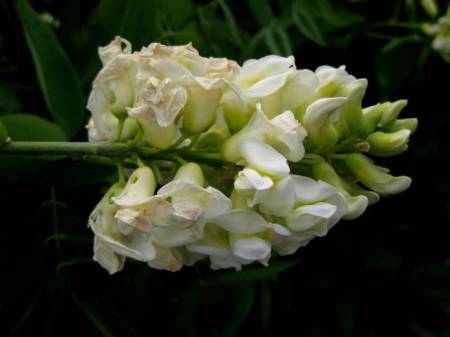 ‘Nivea’ American wisteria
‘Nivea’ American wisteria
.
Native ‘Nivea’ American wisteria, the white-flowered form of W. frutescens, is the final plant in the offer. It is identical to ‘Amethyst Falls’ and produces copious amounts of fragrant white flowers from June to August. It has fine-textured, attractive foliage and is less rampant than the Asian species of wisteria. It grows to 20′ in full to part sun (it is not technically a shade plant) in zones 5 to 9. It attracts butterflies and hummingbirds and is deer resistant.
.
I grow most of these plants in my garden so I know you can’t go wrong by adding them to yours! If you are a customer, click here for details on how to order these wonderful shade plants by noon on May 18. If not, now you have some plants to ask for at your local independent nursery. If you want to read about all the woodies I have profiled, here are the links:
Part 1, Part 2, Part 3, Part 4, Part 5, Part 6, Part 7, Part 8
Carolyn
.
Carolyn’s Shade Gardens is a retail nursery located in Bryn Mawr, Pennsylvania, US, zone 6b. The only plants that we mail order are snowdrops and miniature hostas and only within the US.
If you are within visiting distance and would like to receive catalogues and information about customer events, please send your full name and phone number to carolynsshadegardens@verizon.net. Subscribing to my blog does not sign you up to receive this information.
Nursery Happenings: The 2013 Spring Shrub Offer is now in full swing and orders are due May 18. To read about the plants available and place an order, click here. The 2013 Miniature Hosta Mail Order Catalogue, containing 34 choice selections of miniatures for shipping all over the US, is now on the right sidebar here, and we are ready to ship. If you are local, you can use the catalogue to see what miniatures are available at the nursery. Next up is open hours over Memorial Day Weekend. If you are a customer, expect an email shortly with all the details.
Facebook: Carolyn’s Shade Gardens has a Facebook Page where I post single photos, garden tips, and other information that doesn’t fit into a blog post. You can look at my Facebook page here or click the Like button on my right sidebar here.
Notes: Every word that appears in orange on my blog is a link that you can click for more information. If you want to return to my blog’s homepage to access the sidebar information (catalogues, previous articles, etc.) or to subscribe to my blog, just click here.




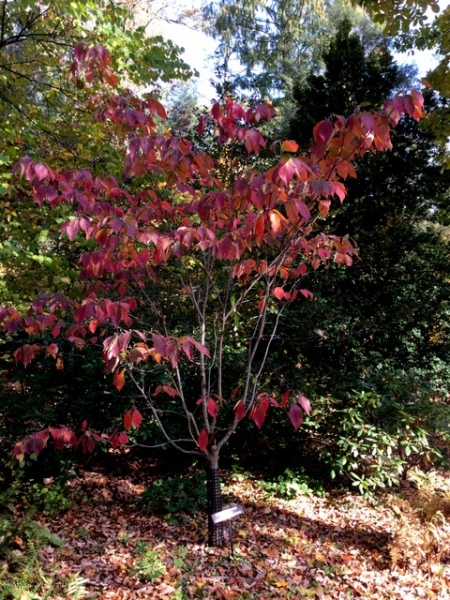
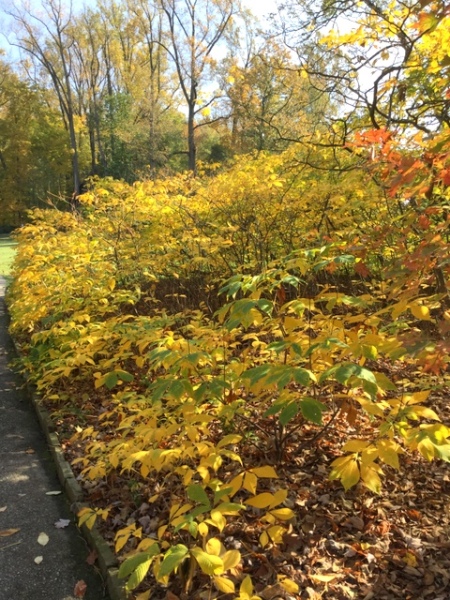
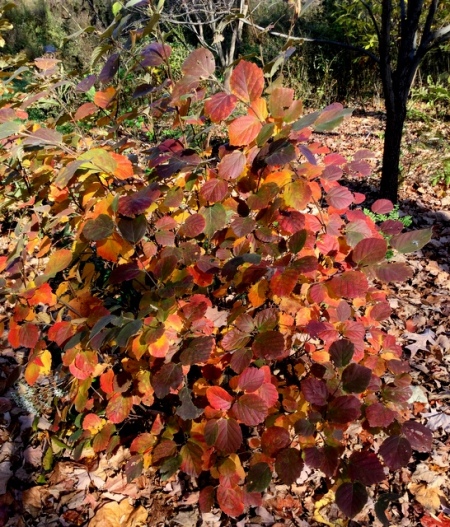



 ‘Prairie Sentinel’ pond cypress, Taxodium ascendens, has a more upright habit than its cousin the bald cypress and is native just south of PA.
‘Prairie Sentinel’ pond cypress, Taxodium ascendens, has a more upright habit than its cousin the bald cypress and is native just south of PA.















































